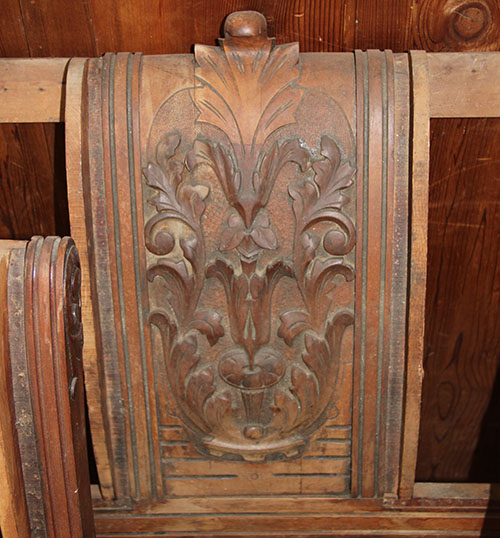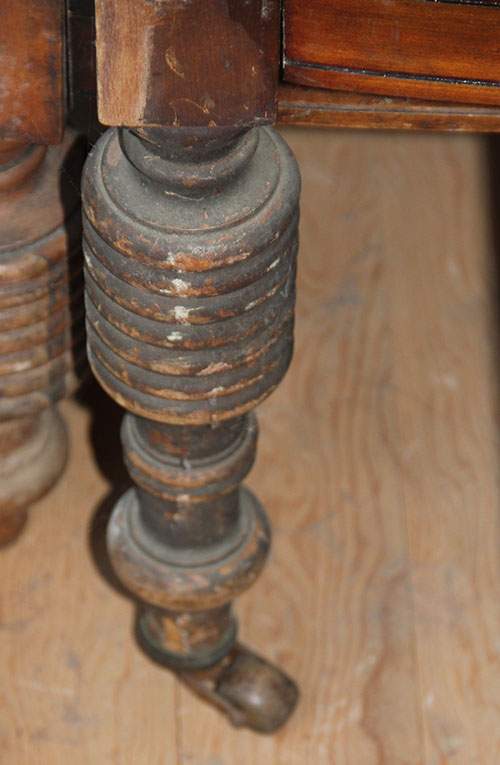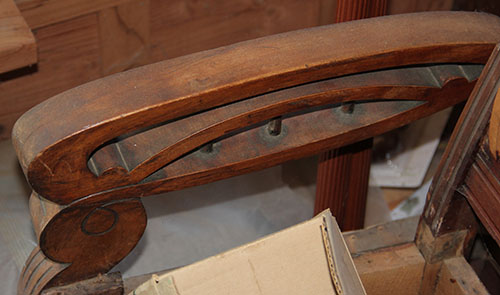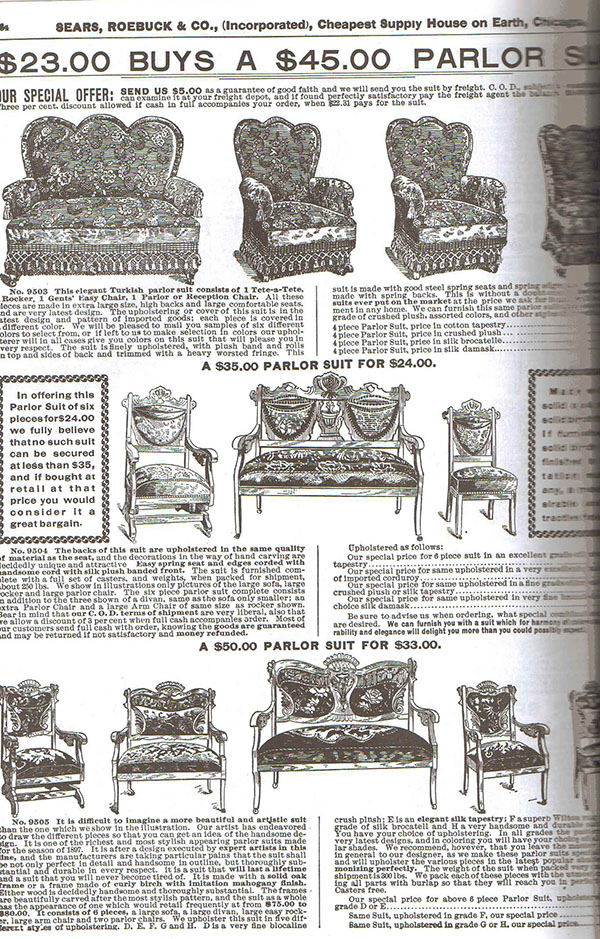The Not So Humble Apron
April 17th, 2013
For the past few weeks, I’ve been helping to install an exhibit of aprons (1880s-1970s) at the South County Historical Society. My job was purely technical — I did some minor wet cleaning, applied plenty of gentle steam to get the wrinkles out, and hand-sewed twill-tape supports until I was cross-eyed (thanks heavens I wasn’t alone on the steaming or sewing). But it got me thinking about aprons.
Of course, the primary point of an apron is to cover up — and often to protect — your clothing. They were (and are) worn by men and women alike, in different configurations according to the task at hand. But aprons weren’t always a matter of simple utility. From centuries past, right up to the 1960s, wealthy women — who never had to lift a finger for housework in their life — regularly wore “dress aprons” as part of their “at home” ensembles. Whether receiving guests in an 18th or 19th century parlor, or mixing cocktails for her husband’s office party, the well-dressed woman donned a frilly apron-shaped confection as a symbol of her domestic dominion.
“You will think I am dreaming when I tell you that a great many ladies have resumed aprons. This fashion is both graceful and convenient : it gives the toilet an air of simplicity which agrees well with le coin de feu…an air of delicate coquetry that is by no means to be disdained.”
The Ladies’ Companion, 1860
Dress aprons appeared frequently in fashion plates, like this one from Godey’s, as well as in the work table department of ladies’ magazines with diagrams for cutting and construction.

DESCRIPTION OF FASHION PLATE.
FIG. 1. – Muslin morning dress, made high in the neck. The corsage is a surplice shape, with bishop sleeves. Apron of plaid silk, trimmed with black lace. Muslin morning cap, trimmed with flowers. The tout ensemble of this dress is remarkable for its simplicity and beauty.
Godey’s Lady’s Book, October 1840; Philadelphia, PA.
Notice the decorative apron on the left? “Morning dress” was meant to be worn in the home, perhaps while receiving visitors making “morning calls,” which, ironically, were never made until afternoon. These formal 19th-century aprons often boasted elaborate decorations — I’ve seen one quite covered in silk-ribbon embroidery — and high, shaped waistbands supported by small pieces of whalebone.
APRONS
If for common use, aprons are made of white, brown, blue, black, or checked linen, of black stuff, calico, Holland, leather, nankeen, print, or long cloth ; if for better purposes, of cambric muslin, clear mulled, or jaconet muslin, silk, satinette, satin, &c. The length of the apron is, of course, generally determined by the height of the wearer, and the width, by that of the material, and by the purpose for which it is intended. For working aprons, the width is generally one breadth of a yard wide ; for dress aprons, two breadths, one of which is cut in half, and these halfs put one on each side of the whole breadth. If the material should be wide enough, one breadth, of from fourteen to twenty nails, will answer very well.
The Workwoman’s Guide, by a Lady; 1838, London.
There was also a distinction made between servants’ aprons that were meant to get dirty — worn while cooking, cleaning, or emptying the slops — and aprons that were meant to be seen.
“Before dinner is served she [the maid of all work] should again wash her hands and change her apron, making her dress as seemly as the nature of her employments permit.”
An Encyclopaedia of Domestic Economy, by Thomas Webster & Mrs. William Parkes; 1855, New York.
By the end of the 19th century, servants’ better aprons had become very formal indeed. Take this one for example. It belonged to someone in my maternal grandmother’s family — though as far as I know, none of them were ever in service.

I also have a number of aprons — both utilitarian and otherwise — that belonged to my grandmother herself, from 1940 through the 1970s.
Tower of Yarn
April 16th, 2013
My radio DJ husband reorganized his massive collection of CDs, and discovered that he no longer needed this dandy metal rack. So I snagged it for my yarn. Or more accurately, a modest portion of my current yarn stash. The rest is still boxed up in the closet. I made it a point to put all the really enticing skeins out in the open, so they will remind me to knit with what I’ve got instead of buying more.

I had no idea I had so much Knit Picks stock already laying around. They keep having these great sales, and I just can’t help myself. I also unearthed a surprisingly vast quantity of lace weight yarn. I feel some collars coming on…
Adventures in Upholstery: Introduction
April 15th, 2013
Most of my textile work to date has been focused on garments. Imagine my excitement (and trepidation) as I embark upon my first upholstery project!
The book I’m using for reference — a gift from a dear friend — suggests a small tufted footstool would be good for my initial endeavor. But I don’t believe in starting slowly.

Here’s the turn-of-the-century parlor suite I’m going to upholster. Without knowing much about wood, I’m going to guess it’s oak. There’s a sofa, a divan, an arm chair, and two side chairs. My mother found them, in this condition, years ago in an East Coast antique store. Her baby brother (whose childhood nickname was Flash) convinced her to buy the lot on the spot. My father was not so quick to appreciate it however, and it lingered in their basement for over a decade before Mom decided to ship them out to me in California. Actually, they’re just the thing for our early 1920s redwood cabin living room. (The house was originally just the single room — later 20th-century additions expanded it to a luxurious 3 bedrooms, 2 full baths.)

The carving is very art nouveau!

Legs on metal casters are typical of parlor furniture from the second half of the 19th century through the early 20th. They made the heavy pieces easy to move around on carpet so the rooms could be rearranged for various uses.

Don’t you just love the open arms? And they’re very strong. The whole thing is quite solid actually.
I sort of wonder who removed the original upholstery — was it the antique store? Perhaps it was in such tatters that they thought the pieces would sell better without it. Or maybe there was some awful intermediate treatment featuring cartoonish flowers from the 1970s…regardless, it’s completely gone. It’s a shame, since the suite would be much more interesting, not to mention valuable, if it were intact. But then I would have to worry about ruining it by using it. So maybe it’s better this way.
I wonder how common these suites actually are? Here’s a page from the 1897 Sears & Roebuck reprint, featuring a couple of similar sets (the two on the bottom):

Based on this, it looks like my suite is missing the rocker. Darn! I adore rocking chairs.
. . . and Old Lace
April 11th, 2013
I’ve been working on another knitted item for my eventual clothing collection — this time it’s a skirt. The overall shape is quite modern, but the bottom boasts a knitted-on lace border adapted from a shawl pattern in Weldon’s Practical Knitter, circa 1885.

Most lace edgings are knitted lengthwise, then sewn onto the piece. It’s rare to find one knitted into the edge, and even more rare to find one knitted down, rather than up. The original directions suggested knitting a square shawl, then using double-pointed needles to pick up stitches all around the shawl to knit the edging. Those must have been some serious double-pointed needles!
The skirt turned out so well, I’ve already found another shawl edging in a later series from Weldon for variations on the theme…
Anticipation!
March 29th, 2013
Waiting for my latest yarn order to arrive at the post office is like watching for the Wells Fargo Wagon of yore.
Today, at long last, it came.

It didn’t take long for me to attack the box with a pair of scissors, revealing the soft, colorful bounty within.

You can mostly just see the sock yarn in this picture. The two on the left, “Fire Fighter” and “Rainbow” are destined for my husband’s increasingly jaunty toes. The colorway on the far right, “Tiki,” is up for grabs if he wants it too, but “Country Fair” below is all mine! Underneath, you can catch just a peek of the alpaca portion of the order. It’s for my long-awaited (or long-promised might be more accurate) Autumn/Winter collection. Trick is, don’t specify the year. So you can always say, why yes, I meant all along that this was to be Autumn/Winter 2013. Or do I mean Spring/Summer 2014…
« Newer Posts — Older Posts »